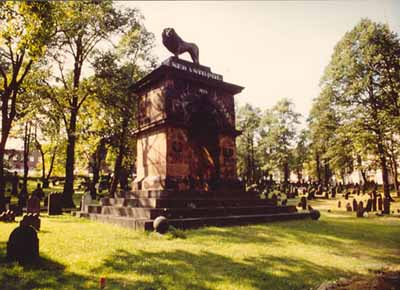Old Burying Ground National Historic Site of Canada
Halifax, Nova Scotia

General View
© Agence Parcs Canada / Parks Canada Agency, 1993.
Address :
1541 Barrington Street, Halifax, Nova Scotia
Recognition Statute:
Historic Sites and Monuments Act (R.S.C., 1985, c. H-4)
Designation Date:
1991-03-01
Dates:
-
1749 to 1844
(Construction)
-
1749 to 1844
(Significant)
Other Name(s):
-
Old Burying Ground
(Designation Name)
Plaque(s)
Existing plaque: 1541 Barrington Street, Halifax, Nova Scotia
The Old Burying Ground, which contains more than 1,200 head and footstones, constitutes a unique concentration of gravestone art. A rich variety of styles, poignant images and carving skills is reflected in these old stones. The winged skulls and the winged heads, or soul effigies, are exceptional. Used by all denominations, the Old Burying Ground served the city of Halifax from 1749 until its closure in 1844. Fenced and landscaped in the 1860s, it was restored as a park and outdoor museum in 1990-1991. It bears silent witness to the complex cultural traditions of early British North America.
Description of Historic Place
The Old Burying Ground National Historic Site of Canada in Halifax, Nova Scotia, contains more than 1,200 head and foot stones, constituting a unique Canadian concentration of gravestone art from the 18th and early 19th centuries. This early graveyard is a 0.91 hectare treed rectangle separated on all sides from its urban environment by a stone wall bearing a decorative iron fence. On its south end, a substantial monument to the Crimean War faces Barrington Street. The burying ground now serves as a significant urban green space.
Heritage Value
Old Burying Ground was designated a national historic site of Canada because: it constitutes a unique concentration of gravestone art; and it bears silent witness to the complex cultural traditions of early British North America
The heritage value of this site resides in the “extra muros” location, the extent, layout and materials of the burying ground and in the rich variety of styles, poignant images and carving skills displayed on its extensive collection of grave markers. Used by various Christian denominations, the Old Burying Ground originally was managed by St. Paul’s Anglican Church, serving the city of Halifax from 1749 until its closure in 1844. The Welsford-Parker Memorial to two Haligonians’ heroic service in the Crimean War was erected at its entry in 1860 when the grounds were also fenced and landscaped.
Source: Historic Sites and Monuments Board of Canada, Minutes, March 1991 and November 1992.
Character-Defining Elements
Aspects of this site which contribute to its heritage value include: its location at what was the outer limits of the 1749 settlement of Halifax; its urban setting, surrounded by formal religious and institutional buildings from the eighteenth and nineteenth centuries; its modest size; its lack of buildings or large structures; those elements which constitute the unique concentration of gravestone art, namely the haphazard placement of graves, the materials (specifically the types of stone used); the forms of head and foot stones as well as box tombs, designs (specifically the motifs executed in a range of high quality craftsmanship and indigenous folk art); and inscriptions of 1253 grave markers, profiling 95 years of cemetery art; those elements which bear witness to the complex cultural traditions of early British North America, namely the inter-denominational nature of the burying ground, and the dual use of the site as a burial ground and urban park. Urban park features include a low stone wall with decorative iron work, the placement of the “Sebastopol” memorial, the informal planting pattern of its mature trees, the surviving “Victorian” tree species such as Scottish Elm, Sycamore, Maple, European Linden, and Horse Chestnut, the winding paths in their extent and routes; its role as an open green space in relation to the surrounding buildings.